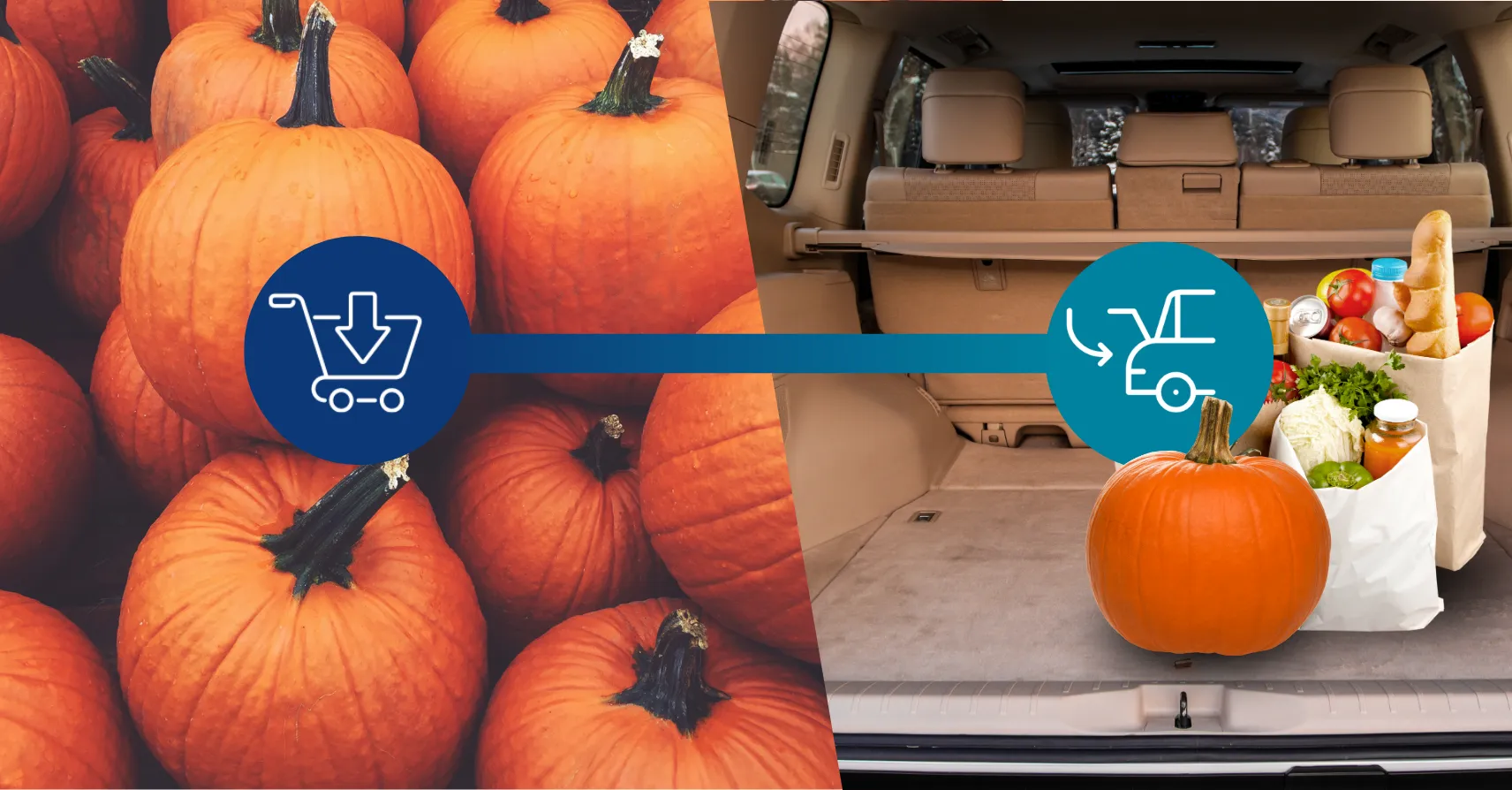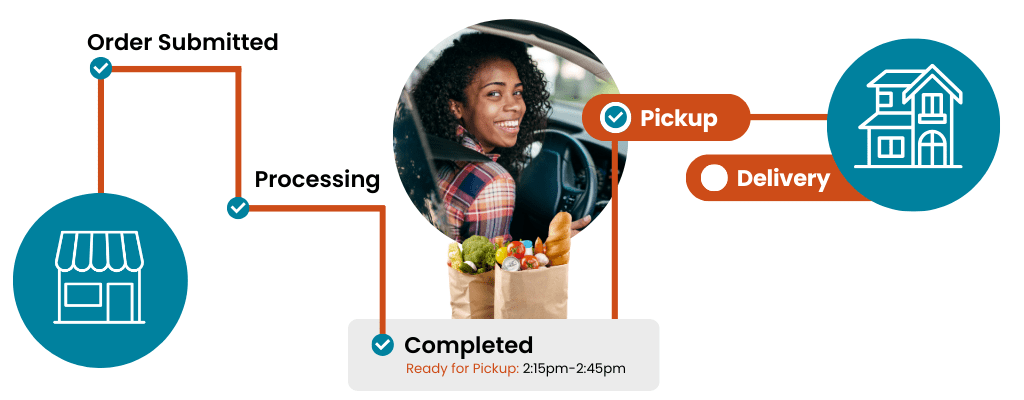
Why Enhancing Online Grocery Pickup Services is More Important than Ever
This article was originally published on August 24, 2022, with the title “The Secrets of Online Grocery Pickup Revealed.” It was updated on October 22, 2024.
“If delivery wins, grocers lose.”
This blunt yet accurate statement from David Bishop, Partner at Brick Meets Click, identifies one of the biggest challenges facing grocers today.
During a recent episode of US eGrocery Sales Insights, I asked David about the impact of Walmart and Instacart’s recent discounts on delivery fees, which have significantly boosted delivery sales and expanded the service’s user base. While pickup remains the preferred fulfillment option for online grocery shopping among US households, its dominance is waning due to these aggressive promotional efforts.
Grocers need to take note of this shift and respond, because, as David explained at the time, “Delivery disintermediates the core strengths that supermarkets enjoy: proximity to their customer.”
Discounts on grocery delivery disrupt customer retention for regionals by:
- Drawing shoppers away from their local grocery stores and
- Undermining the grocer’s control over the customer experience.
Worse, still, they create unrealistic expectations for cheaper delivery services, which has the potential to further erode profitability. Not only is delivery more costly to serve, but—as David pointed out—it also strips local grocers of their key advantages: proximity to consumers and superior service.
That’s why, now more than ever, grocers must communicate and provide increased value on pickup.
By enhancing pickup services, supermarkets can transfer their traditional areas of strength to the digital shopping experience, maintaining direct relationships with their customers and preserving the high-quality service that consumers have come to expect from local grocery stores.
3 Ways to Make Pickup More Appealing than Grocery Delivery
The success of Walmart and Instacart’s promotions once again confirms that consumers prioritize value and convenience when shopping for groceries.
Matching Walmart’s grocery delivery discounts isn’t feasible for grocers aiming to boost profitability. Instead, grocers should focus on the value and convenience that drives the success of these promotions and integrate these drivers into their pickup offerings.
This can be accomplished by:
1. Reducing Pickup Fees
Many regional grocers still charge a fee for pickup services, which might seem like a barrier to attracting more online shoppers. However, this policy can be transformed into a competitive advantage.
Grocers can introduce their own subscription plans that waive pickup fees or offer expedited service. By doing so, they provide customers with added value and create a unique proposition that distinguishes them from larger retailers. This approach not only enhances the perceived value of pickup but also makes it more accessible and attractive.
2. Targeting Price-sensitive Customer Segments
To further increase pickup’s appeal, grocers should focus on attracting price-sensitive customer segments, such as lower-income households.
These shoppers, often deterred by the additional fees associated with delivery and curbside pickup, may not realize the potential savings of buying online. By offering no-fee pickup promotions, grocers can appeal to these demographics, providing them with a cost-effective and convenient grocery shopping option that encourages a shift from in-store to online purchases.
3. Promoting Pickup Services Effectively
Highlighting the value and convenience of pickup is crucial.
Pickup services inherently have a lower cost-to-serve compared to delivery, allowing grocers to offer customers a less expensive fulfillment option. But beyond cost, pickup also offers customers greater control over their shopping experience, allowing them to choose when and how they receive their grocery pickup orders—an aspect of convenience that is highly valued by consumers.
By emphasizing these benefits in marketing efforts, grocers can position pickup as the smarter, more economical choice for customers who prioritize both convenience and control in their shopping experience.
5 Ways to Make Pickup More Profitable
While making pickup services more appealing is crucial for attracting customers, grocers must also ensure that these operations are profitable. After all, the goal of any business is to maintain a healthy bottom line.
But it takes work. It requires a deep understanding of fulfillment operations and a strategic approach to addressing inefficiencies.
Learn how to boost your eCommerce profits in our special TopShelf Spotlight series on optimizing eGrocery efficiency.
To achieve this, grocers need to fine-tune their operations around eGrocery orders—particularly in how they are picked, packed, and fulfilled. By focusing on these areas, grocers can uncover substantial cost savings and boost their return on investment.
1. Introduce ‘Bag as you Go’
Optimizing how eGrocery orders are assembled is one of the most critical, yet often overlooked, aspects of achieving profitability in grocery eCommerce operations.
Every time a product is handled, it translates into labor costs. Inefficiencies in these processes can quickly add up, eroding profit margins on pickup orders.
For instance, each time a product is handled, it takes approximately three seconds. If an average grocery order contains 32 items, this process alone can take nearly five minutes just in handling time. Over 20 orders, that’s an entire hour.
By minimizing these touches—through tactics like “bag as you go”—grocers can eliminate two-thirds of that time, and save significant labor costs while improving efficiency.
2. Optimize In-store Routing
In addition to reducing touches in the pick process, grocers can lower labor costs and improve efficiency by limiting the number of steps involved in the picking process.
One of the most effective ways to achieve this is by optimizing in-store routing.
Just as someone would use a GPS to find the most direct route when driving, grocers can train staff on the most efficient routes and implement technology solutions like mapping software or optimized pick paths.
The most important thing is to be mindful of how groceries are gathered. Two popular options are wave paths and zone paths, as seen in the maps below:
Multi-order zone pick:

Multi-order wave pick:

This approach significantly reduces the time it takes to complete an order, enhancing overall profitability.
3. Implement Batch-picking
With an optimized picking process, grocers are able to streamline order fulfillment and get grocery orders out to waiting customers faster and smoother.
This enhanced efficiency also allows grocers to better operate at scale. Batch-picking or multi-order picking is another powerful strategy to handle peak times efficiently.
This method allows pickers to fulfill multiple orders simultaneously, reducing the number of trips across the store and minimizing the time spent per order. By optimizing labor in this way, grocers can open up even more pickup slots, boosting revenue potential while keeping costs in check.
4. Keep Score on Pickup Operations
How will you know if your grocery pickup program is successful?You’ll want to start by looking at the level of consumer engagement both online and in-store. By deciding in advance which key performance indicators (KPIs) to use—such as sales, budget adherence, order accuracy, and units per hour picked—you can build methods to capture the appropriate data needed.
This also helps set a baseline measurement and identifies how you compare to industry benchmarks, so you can track ROI from launch and beyond.
The best way to do this is by developing simple, visual tools like internal scorecards.
Using a straightforward green-yellow-red light system, grocers can quickly identify areas that are performing well, those that require further observation, and those that need immediate attention.
This approach drives continuous improvement and ensures that operations remain profitable.
5. Get the Entire Organization On Board
To ensure a successful and efficient pickup program, you need to develop a high degree of interaction and integration between your IT, Operations, and Fulfillment teams.
This requires buy-in from the entire organization. To get that, you have to clearly communicate the importance of overall eCommerce operations—including pickup, demonstrating its value, and actively supporting it across all levels.
By linking performance to incentives, investing in targeted training, and promoting eCommerce initiatives both internally and externally, grocers can foster a culture that supports long-term profitability.
Choose the Right Tech Partner to Develop a Profitable Pickup Program
Enhancing pickup programs to reduce operational costs and increase profitability requires more than just good marketing and effective operational strategies.
Grocers need a technology partner that can support and drive their success by offering ongoing support, training, and best practices for seamless implementation and continuous optimization.
A successful pickup service depends on a tech partner who understands the complexities of grocery fulfillment and is committed to helping you achieve sustained profitability. By partnering with an experienced provider, grocers can ensure their pickup programs meet customer expectations and maintain long-term success.
Mercatus is the Tech Partner Regional Grocers Need to Compete
That’s why, at Mercatus, we’re more than just a tech provider—we are a true technology partner dedicated to the success of regional grocers.
We understand that profitable pickup services don’t end with implementation of eCommerce software. They require continuous support, training, and optimization to ensure your entire eGrocery operations remain efficient and profitable.

From refining in-store pick paths and implementing efficient batch-picking techniques to leveraging data for cost optimization and securing team buy-in, every aspect of your pickup service must be carefully managed for sustained growth.
By adopting the strategies outlined in this article and committing to ongoing improvement, grocery retailers can transform their pickup services into powerful drivers of profitability. And with Mercatus by your side, you can confidently overcome the challenges of communicating and providing optimal pickup services to your customers.
To learn more about how Mercatus can help you maximize the profitability of your pickup services, reach out to our sales team today.
 Newsroom
Newsroom
